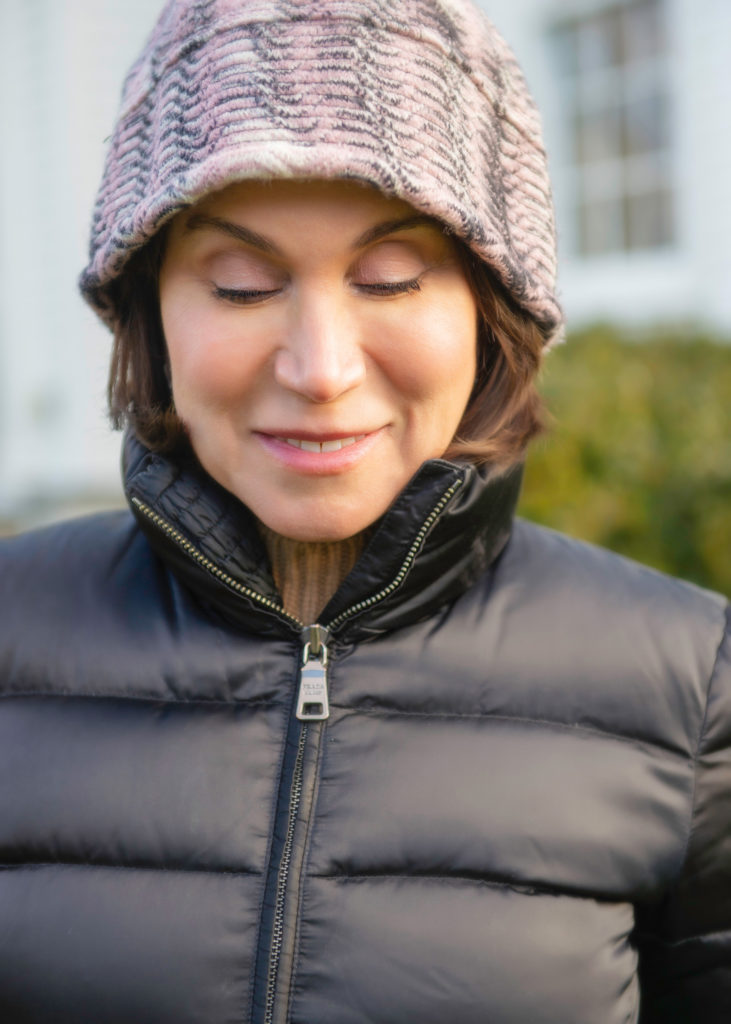
Sure, I’m getting older, my body and my face are changing, and those changes will keep happening year after year. Some “things” on my face might not be in the same place I remembered them a few years ago, and zoom only reminds me of this when my circle light glares directly at me daily. But can those droopy spots go back to where they were – or close enough? Look, a few lines here and there remind of all of the solid living I’ve done so far, but the sagging I see belies the energy and vitality I’m running on each day. There is no slack here, so I want to look refreshed and, well, cheerful.
How do I do that? There are so many products and injectors out there. I need guidance. I sought out my doctor and friend’s advice, Dr. Tina B. West,to explain the ins and out of dermal fillers to fill the hollows and provide a lift to my face and a little in my spirit.
My goal is to look refreshed, not necessarily younger; how can filler help me?
Refreshed is an excellent description of successful rejuvenation! As we get older, our brains detect specific visual cues that identify changes when we look at faces, ours and others, and those aging tendencies dictate age in terms of perception. The goal with fillers Is to change that perception by softening some of the telltale visual cues.
While you have a supberbly healthy diet and a healthy lifestyle, everyone loses collagen, fat, muscle, even bone, even you! And sadly, it begins as early as your 20’s. Although most people may not attribute the changes in their face to volume loss, they eventually start to see sagging or drooping of the skin (jowls), hollowing under the eyes, prominent nasolabial folds, or down turning of the corners of the mouth when they look in the mirror. These changes make them feel like they look tired or angry. Ironically, the more fit and lean you are, the more accentuated volume loss becomes. Thank goodness for fillers! Well-placed dermal fillers’ goal is to replace volume loss early and consistently (as little as once a year) when you start to notice areas of hollowing or sagging.
When you see celebrities, who continue to look the same over the years and don’t look like anything was done (think Jen A!), that is a sign of well-placed dermal fillers. The bottom line is that fillers should be used to replace areas where volume loss has occurred, basically turning back the clock by restoring youthful facial contours. When you look in the mirror, you only see yourself in one dimension. Still, an advanced, board-certified, and trained expert sees your face in 3 dimensions and has specific knowledge of adding volume to areas where it has been lost. This revolumization rebalances the face to restore a fresh, vibrant appearance. Dermal fillers should keep you looking the same over the years, not make you look different. A natural, untouched look is an outcome that requires years of training and experience in full facial contouring.
There are so many ads for fillers in magazines and on-line, are some brands or types better than others?
I’ve been practicing dermatology for about 30 years and when I first started training specifically for facial contouring, we were doing lots of liposuction and fat transfer. Injectable collagen was available to fill superficial lines and lasted about 3 months, but in order to restore facial volume for a more youthful contour, the only available filler was your own fat, which required treatment about every 6 weeks to maintain the results. Over the past 25 years, there have been huge advances in dermal filler technology. Now we finally have the ability to replace volume using manufactured dermal fillers that are safe, reproducible, long-lasting and, in the case of hyaluronic acid-based fillers (Restylane, Juvederm, RHA and others), even reversible.
The bottom line is that the variety of safe, effective dermal fillers that are now available are like an artist’s palette when it comes to replacing volume loss, the current, advanced facial contouring techniques applied by expert injectors requires knowledge of anatomy and a trained artistic eye. Most of the fillers that are advertised in magazines and on TV are very similar, with minute differences in molecule size and cross linking. I customize the filler type depending on very specific factors.
ReVolumize
To address lifting the face as a whole, I trademarked my Facelift In A SyringeTM technique. In this technique I typically use Restylane Lyft®, or the newest hyaluronic acid filler RHA®, to revolumize and lift from the back of the face right by your ears, and rear jaw; so you don’t see it when you look in the mirror but you’ll definitely notice a nice a lift and a reversal of the jowls.
Nasal Labial Folds
For the nasolabial folds, undereye hollows, lips and other specific areas, there are new fillers with “expression” technology, engineered to move more naturally with your expressions so you don’t look frozen. Other fillers, such as Sculptra® Aesthetic, can literally reflate, gently, areas of more extreme volume loss, and some facial contouring experts use this filler most frequently for overall facial contouring.
Jawline, Cheeks, and Temples
Lastly, Radiesse® a calcium-base filler that I often use to define and lift the jawline and can also be used in other areas including the cheeks and temples, with the advantage of lasting longer than most sugar-based (hyaluronic acid) fillers.
Each physician has their own individual preferences; and an expert injector should be able to choose which fillers are most appropriate for you and the lift and softness you want to see. Filling wrinkles isn’t the goal, over all softness and a refreshed face means noticing the nuances of each patients face and seeing what subtle yet effective solutions I can use.
I understand, now, that there is nuance to revolumizing and lifting, now, when should I start using filler?
The question of when to start using fillers is unique to each person. In 2014, there was article published by Harvard dermatologists that asked this very question, and they concluded that the question should really be “when is it too late?” Early replacement of volume loss is key to “prejuvenation,” which is a term for prevention of changes associated with aging. We know that you will achieve the most natural and most effective results by starting early in areas where volume loss first occurs. For each individual, facial anatomy and aging is predominately determined by genetics. For example, if your mother first started to notice undereye hollows in her 20’s, then you are more prone to the same pattern of aging. Some people start to notice downturned mouth corners first, while others may see prominent “smile” lines between the nose and mouth. I have seen some patients in their 20’s who have the same amount of volume loss as others in their 40’s. IT’s really about what you see and how you feel about it.
I’m not going to hide that I love looking good. It makes me feel confident, but I don’t want to look like I’m trying too hard; so, what are the telltale signs of too much filler?
Confidence is what it’s all about! When you start to notice something that bothers you every time you look in the mirror, that’s your sign that it’s time for a consultation with a board-certified facial contouring expert. Many women are concerned about looking unnatural, and that depends on who you go to for fillers. Make sure you go to a board certified, seasoned professional.
You know something is not right when your brain detects when something looks “off” in another person’s face, and in my experience, that most commonly occurs when the face is unbalanced. For example, when a novice injector erases the nasolabial folds, which definitely can be softened, but are a natural landmark that you see even in young children, you will detect that as an unnatural look. Similarly, I often see new patients who have had the nasolabial folds injected, but the corners of the mouth and chin have been neglected, so volume loss there appears exacerbated and the face looks unbalanced and unnatural. And everyone has seen at least one example of overfilled “duck” lips, also known as “trout pout,” which is due to poor injection technique or filler choice or both.
Remember, the board certification should be in dermatology, plastic surgery, or ophthalmologic surgery. Your best bet to achieve a natural outcome is to find an injector who is a member of the American Society for Dermatologic Surgery, a group of physicians who have access to the newest and most advanced techniques and devices for facial contouring.
We have more and better dermal fillers available to us each year, but it’s important to remember that these fillers are like an artist’s palette, and the more experienced and expert the injector, the more natural the outcome.
I know filler is used to make, thin lips, specially seen in women in my age group 50+, look softer, more supple and plump—are there some key spots on the face that really make a difference?
One of my favorite topics is lip augmentation versus lip rejuvenation, because it is so poorly understood by most people and because the fillers and injection techniques have both advanced so much over the past 10 years. It’s common for young women in their 20’s to want fuller, plumper lips and that can be appropriate and improve self-confidence. Alternatively, in the case of many women in their 50’s and above, the concern is that the border of the lip becomes less defined, fine lines form above the lip, and the texture of the lip becomes dry and develops a corrugated appearance; and the last thing that they want is a result that is obvious lip plumping.
Lips
For lip rejuvenation, versus augmentation, there are now fillers engineered specifically to restore the definition of the lip border, soften lines above the lip, and even give a “lip gloss effect,” smoothing the surface texture without looking like anything was done. The fillers that I use for this result include Restylane® Silk and the new RHA® 2. Patients are thrilled with their results, which last about a year.
Jowls
With so much of our current lives taking place on zoom these days, nothing stands out more to me on the face than sagging jowls. Lifting from behind the cheek and jaw with volume (filler) can really make a difference in your appearance. And don’t forget the neck, but that’s another installment on Violet &Verve. Stay tuned!
Dr. Tina B. West is a board-certified Dermatologist and expert in cosmetic dermatology, laser surgery and body contouring procedures practicing in Chevy Chase, Maryland



Hey! Someone in my Facebook group shared this website with us so
I came to give it a look. I’m definitely enjoying the
information. I’m bookmarking and will be tweeting this to
my followers! Fantastic blog and amazing design.
This website was… how do I say it? Relevant!!
Finally I have found something which helped me.
Kudos!
Area 52 delta 8 carts – Area 52 delta 8 carts
Area 52 delta 8 carts – Area 52 Delta 8 THC
area 52 delta 8 THC products – delta 8 area 52
area 52 delta 8 THC products – delta 8 carts Area 52
delta 8 THC area 52 – Area 52 delta 8 carts
Thank you! We love to hear this! Please follow us on Insta! And send me what else you’d like me to research!
Very nice post. I just stumbled upon your weblog and wanted to say that I’ve really
enjoyed browsing your blog posts. After all I will be subscribing to your feed and I hope you write again very soon!
Look at my homepage … buy followers